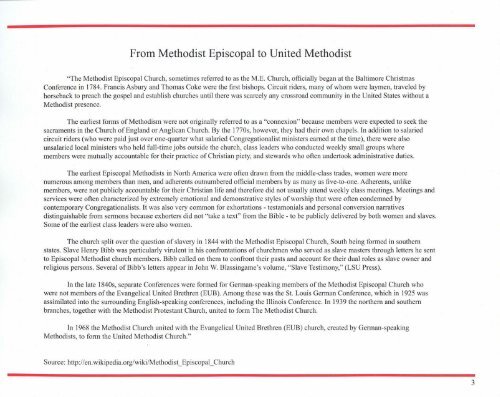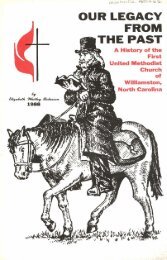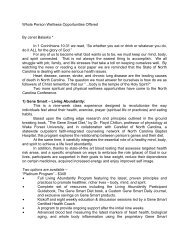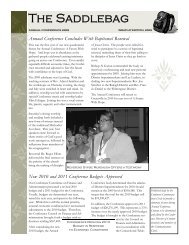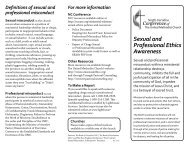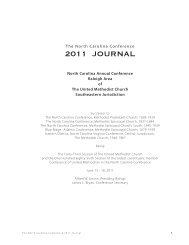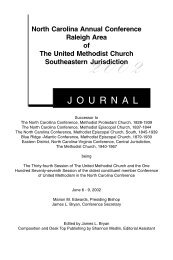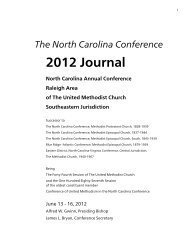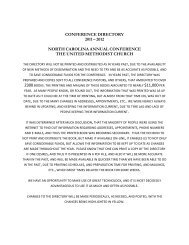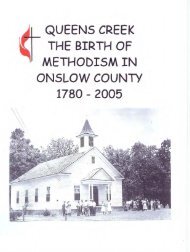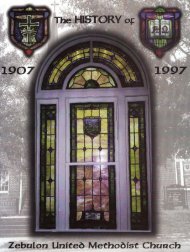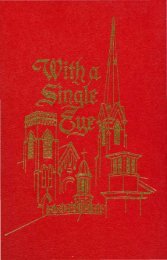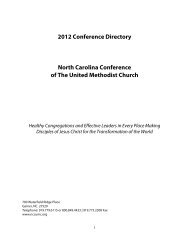A Journey Back: Historic Oak Grove United Methodist Church, 2007
A Journey Back: Historic Oak Grove United Methodist Church, 2007
A Journey Back: Historic Oak Grove United Methodist Church, 2007
Create successful ePaper yourself
Turn your PDF publications into a flip-book with our unique Google optimized e-Paper software.
From <strong>Methodist</strong> Episcopal to <strong>United</strong> <strong>Methodist</strong><br />
"The <strong>Methodist</strong> Episcopal <strong>Church</strong>, sometimes referred to as the M.E. <strong>Church</strong>, officially began at the Baltimore Christmas<br />
Conference in 1784. Francis Asbury and Thomas Coke were the first bishops. Circuit riders, many of whom were laymen, traveled by<br />
horseback to preach the gospel and establish churches until there was scarcely any crossroad community in the <strong>United</strong> States without a<br />
<strong>Methodist</strong> presence.<br />
The earliest forms of Methodism were not originally referred to as a "connexion" because members were expected to seek the<br />
sacraments in the <strong>Church</strong> of England or Anglican <strong>Church</strong>. By the 1770s, however, they had their own chapels. In addition to salaried<br />
circuit riders (who were paid just over one-quarter what salaried Congregationalist ministers earned at the time), there were also<br />
unsalaried local ministers who held full-time jobs outside the church, class leaders who conducted weekly small groups where<br />
members were mutually accountable for their practice of Christian piety, and stewards who often undertook administrative duties.<br />
The earliest Episcopal <strong>Methodist</strong>s in North America were often drawn from the middle-class trades, women were more<br />
numerous among members than men, and adherents outnumbered official members by as many as five-to-one. Adherents, unlike<br />
members, were not publicly accountable for their Christian life and therefore did not usually attend weekly class meetings. Meetings and<br />
services were often characterized by extremely emotional and demonstrative styles of worship that were often condemned by<br />
contemporary Congregationalists. It was also very common for exhortations - testamonials and personal conversion narratives<br />
distinguishable from sermons because exhorters did not "take a text" from the Bible - to be publicly delivered by both women and slaves.<br />
Some of the earliest class leaders were also women.<br />
The church split over the question of slavery in 1844 with the <strong>Methodist</strong> Episcopal <strong>Church</strong>, South being formed in southern<br />
states. Slave Henry Bibb was particularly virulent in his confrontations of churchmen who served as slave masters through letters he sent<br />
to Episcopal <strong>Methodist</strong> church members. Bibb called on them to confront their pasts and account for their dual roles as slave owner and<br />
religious persons. Several of Bibb's letters appear in John W. Blassingame's volume, "Slave Testimony," (LSU Press).<br />
In the late 1840s, separate Conferences were formed for German-speaking members of the <strong>Methodist</strong> Episcopal <strong>Church</strong> who<br />
were not members of the Evangelical <strong>United</strong> Brethren (EUB). Among these was the St. Louis German Conference, which in 1925 was<br />
assimilated into the surrounding English-speaking conferences, including the Illinois Conference. In 1939 the northern and southern<br />
branches, together with the <strong>Methodist</strong> Protestant <strong>Church</strong>, united to form The <strong>Methodist</strong> <strong>Church</strong>.<br />
In 1968 the <strong>Methodist</strong> <strong>Church</strong> united with the Evangelical <strong>United</strong> Brethren (EUB) church, created by German-speaking<br />
<strong>Methodist</strong>s, to form the <strong>United</strong> <strong>Methodist</strong> <strong>Church</strong>."<br />
Source: http://en.wikipedia.org/wiki/<strong>Methodist</strong>_Episcopal_<strong>Church</strong><br />
3


